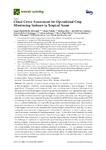Please use this identifier to cite or link to this item:
http://www.alice.cnptia.embrapa.br/alice/handle/doc/1060359| Title: | Cloud cover assessment for operational crop monitoring systems in tropical areas. |
| Authors: | EBERHARDT, I. D. R.  SCHULTZ, B.   RIZZI, R.   SANCHES, I. D.   FORMAGGIO, A. R.   ATZBERGER, C.   MELLO, M. P.   IMMITZER, M.   TRABAQUINI, K.   LUIZ, A. J. B.   FOSCHIERA, W.   |
| Affiliation: | ISAQUE DANIEL ROCHA EBERHARDT, UnB; BRUNO SCHULTZ, INPE; RODRIGO RIZZI, UFPel; IEDA DELÁRCO SANCHES, INPE; ANTONIO ROBERTO FORMAGGIO, INPE; CLEMENT ATZBERGER, University of Natural Resources and Life Sciences, Vienna; MARCIO PUPIN MELLO, The Boing Company; MARKUS IMMITZER, University of Natural Resources and Life Sciences, Vienna; KLEBER TRABAQUINI, Epagri; ALFREDO JOSE BARRETO LUIZ, CNPMA; WILLIAM FOSCHIERA, INPE. |
| Date Issued: | 2016 |
| Citation: | Remote Sensing, v. 8, n. 3, p. 1-14, 2016. |
| Description: | Abstract: The potential of optical remote sensing data to identify, map and monitor croplands is well recognized. However, clouds strongly limit the usefulness of optical imagery for these applications. This paper aims at assessing cloud cover conditions over four states in the tropical and sub-tropical Center-South region of Brazil to guide the development of an appropriate agricultural monitoring system based on Landsat-like imagery. Cloudiness was assessed during overlapping four months periods to match the typical length of crop cycles in the study area. The percentage of clear sky occurrence was computed from the 1 km resolution MODIS Cloud Mask product (MOD35) considering 14 years of data between July 2000 and June 2014. Results showed high seasonality of cloud occurrence within the crop year with strong variations across the study area. The maximum seasonality was observed for the two states in the northern part of the study area (i.e., the ones closer to the Equator line), which also presented the lowest averaged values (15%) of clear sky occurrence during the main (summer) cropping period (November to February). In these locations, optical data faces severe constraints for mapping summer crops. On the other hand, relatively favorable conditions were found in the southern part of the study region. In the South, clear sky values of around 45% were found and no signi?cant clear sky seasonality was observed. Results underpin the challenges to implement an operational crop monitoring system based solely on optical remote sensing imagery in tropical and sub-tropical regions, in particular if short-cycle crops have to be monitored during the cloudy summer months. To cope with cloudiness issues, we recommend the use of new systems with higher repetition rates such as Sentinel-2. For local studies, Unmanned Aircraft Vehicles(UAVs) might be used to augment the observing capability. Multi-sensor approaches combining optical and microwave data can be another option. In cases where wall-to-wall maps are not mandatory, statistical sampling approaches might also be a suitable alternative for obtaining useful crop area information. |
| Thesagro: | Sensoriamento remoto Agricultura Nuvem |
| NAL Thesaurus: | Remote sensing |
| Keywords: | Monitoramento agrícola Clear sky coverage Agriculture monitoring Crop classification MODIS Cloudiness Imagem de satélite |
| Type of Material: | Artigo de periódico |
| Access: | openAccess |
| Appears in Collections: | Artigo em periódico indexado (CNPMA)  |
Files in This Item:
| File | Description | Size | Format | |
|---|---|---|---|---|
| 2016AP07.pdf | 7,14 MB | Adobe PDF |  View/Open |









